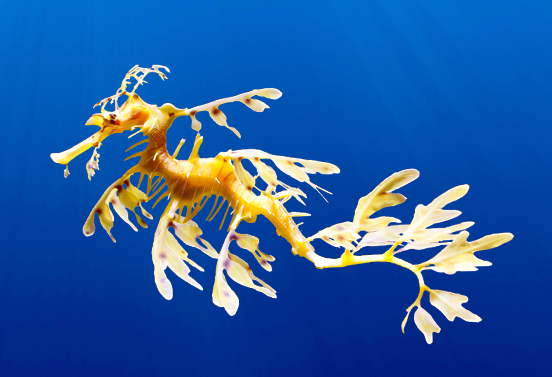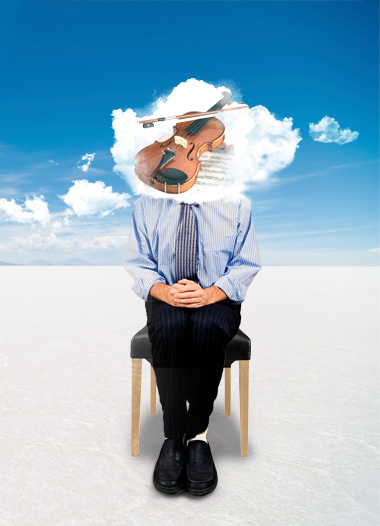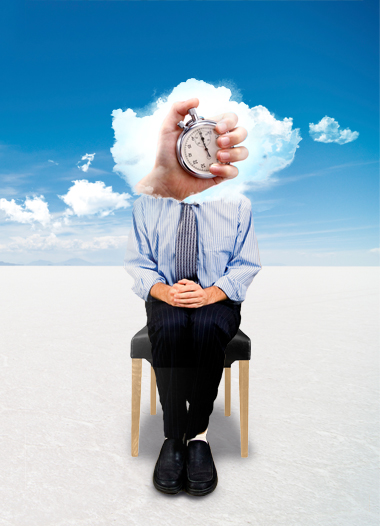How the psyche camouflages its authentic treasures
Von Artho Wittemann
The concept of authenticity is omnipresent in our society. The genuine, the elementary, the profound and true: it's in demand, promised or offered everywhere. As our world becomes increasingly artificial and commercial, commitment to authenticity is growing at a rapid rate.
Is this a contradiction? Is it the fact that everything is becoming more and more artificial that we so long for authenticity? Are we just the victims of profiteers who would have us believe they could still our longing for love with a hamburger? Or could it perhaps be that this mixture of authentic artificiality and artificial authenticity is exactly what we like? And what does all of this have to do with our 'real' human nature?
"While others try to promise everything, we promise only one thing. The most personal, most beautiful and most human of all emotions: joy."
This motto didn't come from a therapist's program or a religious community, nor was it spoken by some guru. It appears on BMW's website. Next it literally says: "Joy is BMW". It doesn't say BMW inspires joy, or even BMW is joy. No: Joy, itself, is BMW.
BMW says quite openly: we're taking the most human of all feelings and putting it like-to-like as our automotive brand. We're taking control of the feeling; we claim it for ourselves and everyone can buy it from us.
Most people would probably agree with the statement: joy is a profound and genuine feeling. Just like love, anger, fear, happiness, and other states, joy is one of the archetypal emotions. They can possess a person to such an extent that he is prepared to throw all precautions, all calculations and all strategies overboard to surrender completely to the pull and lure of this singular experience. Feelings of this purity and depth are genuine.
Resignation, irony or stupidity?

No one has raised any objection to BMW's campaign, no one has filed any lawsuits. But why not? There are several possible answers to this question.
Perhaps we are in a state of collective resignation and are generally overstressed. We are too exhausted to defend ourselves. We are assaulted out of all directions with claims that we can't do anything about even though we know they aren't true. No matter where we look, our deep feelings are devalued. McDonald simply asserts: I'm lovin' it. We can't go into every McDonald's and protest against this statement. The only thing we can do is boycott - but Mcdonald's wouldn't even notice, given its huge sales. VW's German slogan: “Out of love for automobiles”. Alfa Romeo: “Burning passion”. Peugeot: Catch spring fever. Pause for breath: a Lufthansa product. Where should one even start to take a stand?
But perhaps it isn't fatigue and resignation at all that make us appear so apathetic towards all these curious claims. Perhaps we have become so good at simply not taking advertising claims seriously that even an obviously twisted saying such as "Joy is BMW" no longer triggers any reactions in us. With elegant ironic distance we protect ourselves from advertising that wants to exploit our true feelings. We know the rules; we know what game is being played and we remain the secret winner. We are sure that we are not fooled by authentic looking bait. We put on a t-shirt that was already faded at the time of purchase and upon which is written "authentic wear" and we grin to ourselves because we know that at the same moment millions of identical t-shirts are being worn. Millions of identical authentic shirts.
Resignation ("it's hopeless") or ironic distance ("you won't fool me") could explain our ever increasing tendency to put up with things and shoulder-shrugging attitude. Maybe everything is much simpler; maybe we're all just too stupid to really notice the trick. Maybe we are just unsophisticated, stimulus responsive primates, and one only has to wave a banana in front of our faces for us to grab it. And if real bananas are too expensive and hard to come by, then bright yellow artificial ones can be used to trigger the grasp reflex. The less authentic the artificial one is, the cheaper it's production; the more true-to-life its appearance, the better its effect will be. Modern technology allows for both: the absolutely real-looking cheap copy.
But there is, in addition to resignation, ironic distance and stupidity, a fourth possibility that we should seriously consider: We're not having the wool pulled over our eyes at all. We are being given exactly what we want and this desire is natural. Everything is exactly the way we want and need it to be.
The love of a turtleneck sweater
Just recently a big fashion house distributed an elaborate advertising brochure for cashmere sweaters. In the cover photo, a very beautiful young lady demonstrates that you don't even have to wear a sweater to keep you warm. "Tempt your skin" is written next to it. The young lady seduces us on over 20 further pages of the catalog and, in addition to her photos, we find little love letters. But they aren't from the young lady; no, it's the cashmere sweater itself, which is directly addressing our skin. "Beloved skin", it says, for example, "without you I am nothing, coming apart at the seams and have no reason for being. My cashmere lies on the ground, ruined. Take me home and make me the happiest sweater in the world. With all my love, your turtleneck."
Suppose we wanted just that: deep confessions from sweaters, human feelings for automobiles, faithful love to ready meals. Suppose that we can identify more with the artificial real than the 'real' real. And suppose the reason could be found neither in our resignation, nor in our callousness, nor in our primitiveness, but in our true nature. We'll continue to explore this idea in the following.
In Search of the True Self
The diagnosis and description of human alienation in modern society is of course nothing new. Many have recognized and deplored our departure from our original nature. Many valuable suggestions have been made concerning measures which could reverse this trend.
Already at the dawn of modern psychology, Sigmund Freud introduced the topos of authenticity: in his model, the Id represents the original impulses and drives unlimited by any rules and constraints of civilization. When Freud recommended allowing young people to have sex before marriage, he was met with fierce protest. For his day and age, he was a courageous advocate of liberating natural impulses. His entire treatment approach was based on the idea of reversing the suppression of these impulses and integrating them into the ego-consciousness.
However, according to Freud's view, the superego stood in the way of the id as its opponent. The super-ego has no regard for authentic emotions; it is only interested in adapting us to the demands of society as subtly as possible and in order to achieve this it arbitrarily sacrifices the honest and true impulses of the id. Self-alienation and neuroses are the result.
This model of dualism has greatly shaped our understanding of the internal dynamics of the psyche. Since Freud we have believed that the true and the false are two opposing antagonists in a struggle. This belief finds its expression in countless psychotherapeutic and spiritual teachings and practices.
Some seek their true self in vital expressive power, some in willful self-determination and some in universal transcendence. They almost always see that which is currently considered to be "real" threatened by internal and external constraints that need to be identified and overcome.
But does this view reflect the actual situation?
The sea dragon and his brothers
The natural world is often cited as a model for a genuine authentic lifestyle. Aren't the animals and plants true to themselves? Don't they show us in a wonderful way what the original way of life looks like? The fact that animals and plants are in a constant adaptation and survival struggle, is easily overlooked.
Take for example the sea dragon: it looks like old rotten algae and therefore no one is eager to devour it. With its looks, it is not only denying its true nature as a fish, but it also appears to not even be really there. Its disguise is ingenious.
Is the sea dragon authentic? Or does he want to be freed from his disguise? Does it suffer as a result of its strategic appearance because it makes it impossible to swim around faster or look as elegant as other fish?
Or is it perhaps more likely that the camouflage strategy of the sea dragon precisely reveals its true nature? Then the camouflage (algae) and the actual thing (fish) would not be two very different things that are competing with each other, but they would derive from the same original will, the will to live and to survive in a hostile world. The sea dragon can be proud of its solution and it will continue to work on it. Maybe a new small movement can offer it a distinct advantage and allow it to move in a current faster without blowing its cover. Or a new shade that makes it appear even more similar to algae floating by.
The natural world is pervaded by this ingenious and unconscious intelligence, as displayed by the sea dragon. The most amazing of strategies allow organisms to survive and develop further.
We can see from this example that authenticity in nature is not self-evident. If it is necessary and possible, animals make themselves completely invisible, play dead or mimic other animals and even objects. This quick-change artistry is a solution, a triumph of survival. Why should this be any different with the human psyche?
Looking at things this way the true and the false are no longer antagonists because they come from the same source. They are an expression of an intelligent yet unconscious will, which instinctively recognizes that it is threatened in its original form and is now making every effort to develop a new form that protects it. It is proud of this protection. It doesn't wait for someone to free him from it. At most, it waits for someone to recognize the intelligence and ingenuity of its solution.
Internal sources
If we examine the psyche in an unbiased manner, then we can see that it works in exactly the same way as the sea dragon: it can change its appearance beyond recognition, it can completely adapt to its environment and it can expertly play dead. Its repertoire of tricks is huge and it is constantly learning more. But how are these acts of transformation related to what we experience as the true, the real, the authentic in us?
The answer to this question is not as easy to find. The reason for that is related directly to the ability of the psyche to confuse and keep anyone at a distance with numerous tricks and distractions, without even needing a hint of consciousness to do so.
Freud concluded that due to this unconscious resistance that it is impossible to examine the depths of the psyche directly and systematically. He therefore instituted the interpretation of visible phenomena - such as dreams, memories or behavior - as the central tool of psychoanalysis.
Freud assumed that the visible phenomena of the psyche come from three different sources - ego, id and superego. He regarded the ego as the conscious and reasonable portion of the psyche, the id as the source of instincts and unshaped impulses, the superego as an instance of social rules and expectations. So from the very beginning Freud decided to label the sources. He assigned certain properties to them which seemed plausible, but, as he himself believed, weren't able to be directly examined and verified.
How much more elegant and productive it would be if we could travel the depths of the inner world directly in order to explore its intimate workings. To achieve this, we need only to make a small change to Freud's starting point: we maintain his basic idea of the different sources, but refrain from assigning these sources certain properties from the outset. We admit to ourselves that we aren't able to understand the sources based on their visible surfaces. This gives us the freedom to examine the surface of the source as it is without having to jump to conclusions as to its depth.
If we catch a sea dragon, we don't cry out: Oh look, seaweed! We also don't exclaim: Oh, a fish disguised as seaweed! We just say: Looks like seaweed - can I do this too?
Like-to-like
If a person wants to know which sources act unconsciously in him, he can investigate them very directly and systematically with a little support from outside.
For this he needs an opposite, a facilitator with special abilities. The facilitator must be able to be completely receptive towards him, to obtain precise understanding of his behavior and then become like him, without drawing any conclusions from it. When a person says, "Good to see you!" his counterpart will perhaps answer in a very similar manner. "Yes, I'm also happy to see you!" And then a dialogue can develop after the introductions between the two who are now "like-to-like". Suppose that the client's statement comes from a really warm-hearted source and is sincerely pleased to see the facilitator. Then the facilitator will answer from a friendly source and soon we will have two people engaged in warm fellowship. They both feel open, close and familiar.
So far this all seems very normal and known. But the facilitator has now completed a major paradigm shift. He is no longer interested in the client's words or information. His primary interest is the source that these words are coming from. This paradigm shift is the key element that will completely change the encounter.
Relationship vs. Information
The facilitator becomes similar to his opponent and he insists on this similarity. He even accentuates it more intensely than the client himself. He becomes - in our example - a bit more warm, welcoming and friendly than his counterpart. But not only with words! His gestures, his facial expressions, his attitude, his emotions, his inner images, and even his own energy field condense this special kind of warmth offered to him by the inner source of the client. It generates a resonance phenomenon and the result is an extremely unique, intense relationship between two alike individuals.
What at first glance might seem like a trick is in truth an art that requires a lot of development, clarification and practice on the part of the facilitator. It has nothing to do with imitation, not even with the commonly known forms of pacing or mirroring. The success depends entirely on the level of inner freedom that the facilitator has reached in his own system. For his own inner sources must be ready to engage the other person as straightforwardly and intensely as possible and seek out such contact using just his own will.
Let's recall: camouflage, ambiguity and confusion are universal, ingenious and unconscious mechanisms. Therapists are no exception to this rule. Their own internal sources have also protected themselves well and inconspicuously. To be like-to-like represents an enormous challenge because one must drop this protection and clearly relate to his counterpart without knowing where it will lead. You can't simply create such art forcefully.
When contact is made and the resonance phenomenon begins to come in effect, several crucial things occur simultaneously: intense contact is established, great clarity and alertness with which even the smallest changes can be perceived. What does this mean for the inner source being focused on? It can no longer be evasive. It is at the center of attention and is empathized with and given affirmations in the smallest of steps. Any further movement is immediately matched and deepened. It shouldn't be changed of course, not even understood, but fully recognized in its current state-of-being and reinforced.
Layers

In our example, the warm openness begins to slowly cool down. Imperceptibly at first, then more and more clearly the source's mood begins to swing in the other direction. It isn't used to being encountered so persistently and being served what it dishes out. Normally your counterpart will be pleased with your friendliness towards them for a short time and will then focus on the information which it brings into play. This can be anything that lends itself to conversation at the given moment: from the weather over the course of therapy to socially relevant issues. But now each of the source's attempts to establish an issue at the center of attention ends back at it and how it does it.
It first becomes nervous, then defensive and finally openly dismissive. The facilitator goes along with the change again, always close to the pattern of the source itself, always answering in a similar manner and thus affirming the change. Warmth turns into nervous retreat followed by muffled silence and finally powerful repelling superiority. And finally, after several hours, the source reveals itself in its actual, original and intrinsic form: as an upright, energetic, confident, serious and clearly decisive person - the very qualities which he had sorely missed in his life. "I'm always too friendly, I never get my way", were his first words at the beginning of the process.
"I had to hide my power and my opinions!" were the words of the inner source, as it ventured for the first time to reveal itself in its unadulterated form. "If I hadn't cloaked my opinion with friendliness and retreat - I think I wouldn't have survived the attacks."
Self-repression
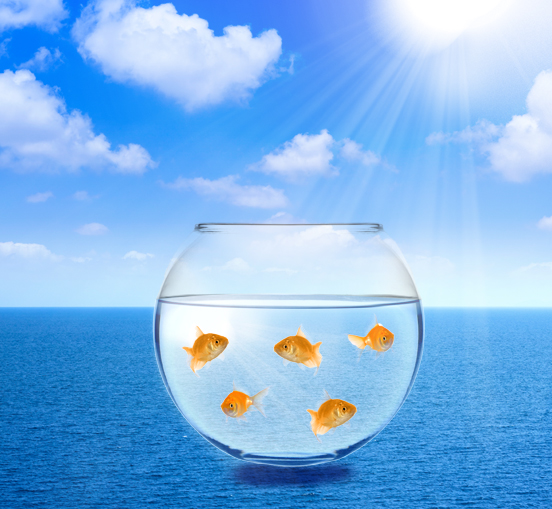
It was therefore the internal source itself which had concealed its energetic, confident, serious and unique qualities under layers of harmless warmth, withdrawn and contemptuous attitudes and a large amount of different information. That was its salvation, its solution in the face of an overwhelming hostile environment.
Here no impulses had been suppressed by a super-ego. The suppression came from the same source as the impulse. The source itself protected itself from enemy access. With unconsciously-genius intelligence, it found a way to disguise itself and not offer a potential target anymore. Like the sea dragon, it offered a harmless, meaningless and confusing multifaceted view. In this manner, its essence, its original skills and values were protected from attack.
The side effects of this self-repression were, of course, considerable. The whole energy of the inner source, its uniqueness, judgment capability and determination were no longer directly available. Where it - as according to its nature - would have originally firmly said no, it now had to perform complex maneuvers involving friendly distractions. Where it would have naturally taken a definitive path, it now had to muddle along aimlessly.
But what would it have done if one had suggested to it to practice a bit in clarity, asserting itself and setting boundaries? It would have, in accordance with its camouflaging capabilities, first accepted this suggestion, discussed it in detail and then inexplicably let it end nowhere. And it would have celebrated this success.
The Big Deal

Almost all of our internal sources have gone through a similar process of self-repression. They have buried their essence, their original and unique skills, under layers of camouflaged attitudes and information. They have done this with the same blind yet brilliant intelligence that seems to work in all living things. They have unconsciously learned and understood that the natural, the unique and the true are not rewarded in this life, but sooner or later will become a target for those who want to assert themselves or are pursuing other aims.
Approximately 15-20 such sources can be found in a person if we systematically examine their internal system in the manner described above. Some are visible to the world (at least with their camouflage), others are completely submerged in the depths of the inner world. In turn, one can get to know them and investigate them from their surface down to their essence.
The longer you deal with them, the clearer it will become how welcoming the internal sources are to all the offers that help them to keep life, people and the world at a distance but at the same time still be able to take part in it a little. Television, cinema, internet, advertising, cars, vacation packages and meals correspond to their exact fundamental solution: they offer a touch of liveliness and remain at a distance. They give love and let you be. They deal with the truth without touching it.
That joy - "the most personal, most beautiful and most human of all feelings" - is synonymous with BMW, that sweaters write us love letters, that a pause for breath is a product of Lufthansa - is very pleasing to our inner sources in their unconscious disguised attitudes. It supports them in their efforts to protect their most precious possession - their unobstructed ensouled authentic will - by concealing it with distractions, smokescreens and deceptively genuine copies. It gives them the promise that their treasures are recognized yet still continue to be left in peace.
There is a universal contract, a big deal, between the internal sources and the manufacturers of these virtual pleasures. They need each other. Artificial is natural. Once we understand this, we will know where we can find what is real.
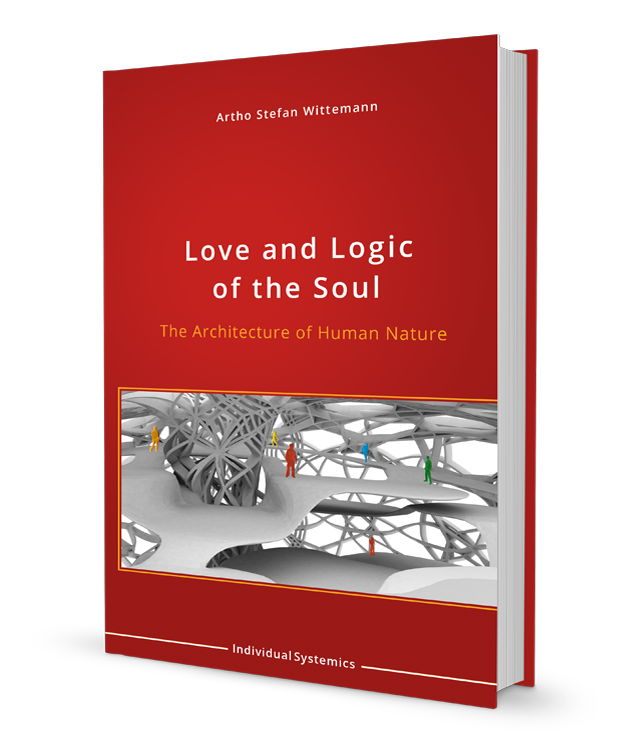
Love and Logic of the Soul
by Artho S. Wittemann19,50 € as E-book | 24,70 € as print| 352 pages
Find out more about this book right here in our shop








